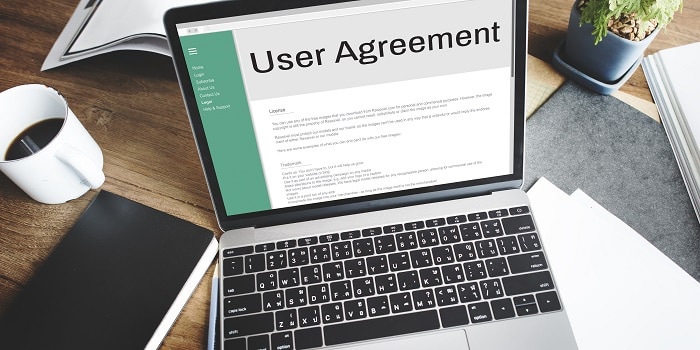Need any help? Contact us:

Table of Contents

If your business develops and leases software applications, a comprehensive end-user agreement is essential to avoid any legal issues. By ensuring you retain the rights to your product and preventing customers from misusing it, you protect your business and its assets from abuse.
But how do you know which legal template is best for you and which components to include to ensure your agreement is solid?
Putting together strong end-user agreements can be time-consuming and challenging, especially if you’re unsure where to start. This article will discuss the basics of end-user agreements, why you need them, and the essential elements you must include.
What is an end user agreement?
An end user license agreement, or EULA, is a legal document that establishes a business agreement between your company and its customers. It essentially acts as a contract, setting out the terms of the agreement between you, as the developer or publisher of the software, and the end user, or the customer who has purchased your software.
When you sell your software, you grant the customer a license to use the application. In order to download the product, the customer must agree to the terms set out in the EULA.
As the term ‘end user’ suggests, the document explains precisely how the people your product is designed for are—and are not—allowed to use it. For example, you might let your software be used for personal reasons but not commercial ones.
When and why do you need a EULA?
End-user agreements are beneficial in a variety of situations. Most importantly, a clear and comprehensive end-user agreement can protect a company’s intellectual property, establish user expectations, and mitigate potential legal risks.
Put simply, a EULA protects you and establishes legal boundaries.
You need EULAs anytime you want to set such boundaries or are creating something that has the potential of being misused. They’re also necessary for copyright reasons.
EULAs and business operations
Any business that operates by putting out products for end users can benefit from using EULAs to ensure operations run smoothly.
By setting out the precise terms of your product’s intended uses and interactions with customers, you both protect yourself and inform customers about the details of your product.
As EULAs are, therefore, a form of risk management for both parties, especially the business, you’ll need proper tools to create them. A risk management API integration platform goes a long way toward this goal, as does a dedicated EULA-creating tool.
Essential elements of an end-user agreement
With that in mind, let’s dive into the essential elements of an end-user agreement that you must include.
- General introduction: Start with the most straightforward component: an introduction. It’s vital to put together an introduction, so you avoid jumping into the specific terms of the agreement. The introduction should make two things clear. The first is that the document that follows is a EULA. The second is that the EULA pertains to a legally binding agreement between your customer(s) and your business.
- Information on the licensor: Who created the software in question, and how can they be contacted? This information is vital to include as it establishes who is behind a product. This information may be included as its own separate clause in your EULA, just as it can be included as part of your general introduction. If the software is known under multiple names, those should also be listed here.
- License version: Your software may be designed for multiple purposes, groups, or individuals. If that’s the case, it’s crucial to make sure you’ve clearly labeled which version a given reader has access to. Keep in mind that your intended user groups may overlap. In that situation, this clause should establish which types of people or companies a given version does apply to. It should also be very clear about which types of end users are excluded from any specific agreement.
- Use purposes and restrictions: What may your software be used for? Which uses do you expressly prohibit? Your EULA should leave no questions in a reader’s mind about whether your product is suitable for the needs they have in mind. To that end, it’s a good idea to list general and specific purposes. For example, you might list ‘commercial purposes’ alongside more specific commercial purposes you want to call attention to. It can also be helpful to list out whether a use-purpose is permitted or intended. For example, when it comes to commercial purposes, you might have ensured your product has PCI compliance, in which case dealing with the payment card industry is an expressly intended purpose.
- Conditions for termination: An end-user agreement always aims to give companies at least some measure of both external and internal control of the software they create. This is why EULAs need to set out the service termination conditions. This ties in with the previous clause about restrictions. For instance, you might state that using the product for any purpose but it’s intended one(s) can lead to immediate termination. In other words, you’re explaining the consequences for prohibited actions, which users agree to by accepting your EULA’s terms.
- Ownership: It’s likely that your product is your intellectual property. So, your end-user agreement needs to make this clear. It should also establish that buying or downloading a copy of your software does not transfer ownership of the actual product to its end users. That ownership lies with you, as the software itself belongs to your business. Make this clear in your EULA.
- Disclaimers: You’ll want to be clear about what you will and will not be liable for. This clause can ensure you’re absolved of any legal responsibility for things like misuse of the product or adverse effects on its users. It’s also worth including disclaimers concerning other products, services, or companies with similar names to distance yourself from them legally. If someone buys your software thinking it’s another piece or product with a similar name, you need protection from legal repercussions. Additionally, if your software is sold physically, it may be shipped in custom shipping boxes which are subject to their own terms and conditions.
- Copyright information: As mentioned, your software belongs to you and you reserve copyrights. This needs to be stated in no uncertain terms. The consequences of copyright infringement should also be established. When it comes to copyright, it’s always critical to ensure copies of your products are created and distributed in accordance with the law. Your end-user agreement should clarify that users can’t take that distribution or creation into their own hands. In the same way that you can rely on tools like Make document control to protect the distribution of your documents, you should be able to use your EULA to do this with your product.
Final thoughts
End-user agreements protect your company’s interests and rights and help your business secure a safe relationship with its customers. By establishing precisely how your software can and cannot be used, EULAs also clarify, in no uncertain terms, what you will and will not be held responsible for as a company.
In a word, they’re a type of safeguard.
The list above is made of the most essential items to include in your EULA. But keep in mind that it is not exhaustive. Your specific business or software might come with additional requirements for your end-user agreement, so be sure to double-check you have included all of the necessary requirements to cover your bases.




